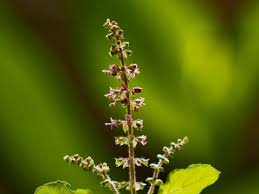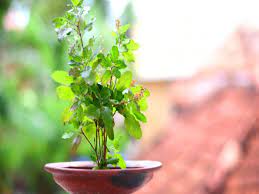Medicinal tulas ( Sacred basil )
Medicinal tulas ( Sacred basil ) – Names in different languages – Hindi, Gujarati, Kannada, Sanskrit – Turya, Tulsi, English – Sacred Basil, Holy Basil, Latin – Ocimum Sanctum. This familiar herb is soft, deciduous (perennial), hairy, branched, 30–75 cm. tall and found everywhere in India. Also found in the Himalayas up to 1,800 m and in the Andaman and Nicobar Islands. It is commonly cultivated in gardens. Tulsi is mentioned as Suras in Charaka Samhita and Panini’s Ashtadhyaya. Also there are stories related to Tulsi in some Puranas and Upanishads. Ayurvedic treatment also mentions the properties of Tulsi. Leaves are simple, opposite, oblong rounded, entire or often dentate (serrated) and pinnate and glandular (glandular) on both sides.

Flowers crimson or purplish, small, borne in simple or branched racemes [punjavalari pushpabandha] at the tips of the branches and main stem. Seed round, slightly flattened, smooth, pale brown or reddish [labiate]. Tulsa is sacred to all Hindus and is planted around temples and at home. It is used for worship in many religious rituals. There are mainly two varieties of it in cultivation: one green (Shri Tulsa) and the other with crimson leaves (Krishna Tulsa). Basil can be properly planted by making seedlings from seeds. Diseases like powdery mildew, root rot, karpa etc. fall on her.
Must read – Sesame
The leaves yield a yellow-yellow, slightly clove-like, volatile (volatile) oil by steam distillation (the act of separating components by releasing steam bubbles from a hot liquid). It is a disinfectant and insecticide. The seeds also yield 17·8 per cent greenish yellow fixed oil.
The leaves are expectorant (expletive), their juice is diaphoretic and useful in menstrual fever, stimulant and reduces bronchitis. Drops of the juice are placed in the ear for earache and applied externally for nits and other skin diseases. The powder of the dried leaves turns brown when crushed. The seeds are effective in urinary disorders and some genital disorders. Root decoction is good for sweating in fever, leaf decoction (extract soaked in cold water) is useful in stomach disorders in children.

Ranatulas : (Ramatulas no. Vriddhatulsi in. Shrabi basil la. Ocimum gratissimum). It is a perennial (living for many years) 1–2·5 m. It is a tall shrub and is found all over India and also in Lakshadweep islands. Many of its physical symptoms are similar to Tulsi. The flowers are pale greenish yellow and appear in denser clusters on the stems. It has a strong odor and the oil is antiseptic and less toxic. The oil is used for earache, toothache and stomach ache in children. Leaf extract is given on Shukra (Semen) weakness and Parma. Dandelion is digestive, nutritious, stimulant, sedative (calming), diuretic (cleanses urine), antiseptic (prevents the growth of microorganisms or destroys them) and antiemetic (stops expectoration). Leaf juice is given for stomach ache. B is useful in headache, neuralgic colic (severe pain in nerves), dysentery etc.
Vaishnavites wear garlands of beads (tulshimala) of tulsi roots or stems.
Like to read – Palmyra palm
Medicinal uses of Tulsi
Tulsa is not only religiously useful but the importance of Tulsi in Ayurveda, medical field as well is amazing and countless. Basil is classified as a herb, so basil is the most useful and number one herb. This Tulsi has many uses which we cannot even imagine, so let’s see how Tulsi is a medicinal plant with religious uses.
Provides oxygen
The biggest and most important use of Tulsa is that it supplies us with the most important oxygen that we need in comparison to other plants. According to plant scientists, basil releases oxygen for 20 hours a day and carbon dioxide for only four hours.
As Tulsa releases more oxygen and vital gas compared to other plants, one should have Tulsa in front of one’s door, and circumambulation of Tulsi in the morning or evening also improves health as the person who circumambulates gets maximum amount of vital gas, thus religious as well as Ayurvedic. Also Tulsi has gained a unique importance, this is the most important benefit of Tulsi.
Effective against cold, cough, phlegm
Tulsa is effective in cold cough
Tulsa is a herb that is effective for internal disorders as well as being very beneficial for external disorders as well. In case of cough-phlegm, Tulsi juice boiled in water reduces throat infection to a great extent. In the current situation, during the Corona period, almost many people took Tulsi leaves and other medicinal leaves and took them to protect themselves. From this, it can be seen that Tulsi helps to increase the immunity in a lot, and this Tulsi also has the ability to protect us from many small and big diseases, that’s why, if there is a cold-cough, everyone, from very young to adults, is given a decoction of Tulsi water.

Increases immunity
Tulsi leaves should be eaten on an empty stomach
As we mentioned above, eating 4-5 leaves of Tulsi every morning on an empty stomach not only protects us from all diseases and also increases our resistance to those diseases. Drinking tulsi water boiled in hot water does not cause any throat or phlegm infections and also protects against viral diseases.
Tulsi water should be consumed if you want to ward off any disease, it works like an elixir, so even if you have a simple wound in the past, apply Tulsi water on it, or if you are constantly sick, have a constant cough, cold, cough, nausea, bile or being sick. If there was a problem, then Tulsi leaves were given to the person to increase immunity.
Uses in Vitiligo :- Medicinal uses of Tulsi
Basil is very beneficial for skin
Tulsi not only has antibacterial properties but also has many medicinal properties that affect skin infection. Many children have the problem of getting white spots on their skin due to lack of nutritious food or lack of vitamins and minerals or due to some skin disease, in such cases applying Tulsi water juice to the place where such spots are present will automatically reduce the spots. occur, and then disappear after a few days.
At the same time we see that if any part of the body is itchy due to some reason, applying the juice of fresh tulsi leaves to that place will also remove the skin infection due to its antibacterial properties. Thus, Tulsi leaves are used for one or more skin disorders, and hence Tulsi is used for skin diseases.
Also read – Tandulja
Deodorant :- Uses of Tulsi
As you may know, Tulsi water has a pungent aroma, so Tulsi leaves are widely used for deodorizing. Sometimes we get a slight fever or due to some other reasons we smell from our mouth, then by chewing tulsi leaves in the mouth, the bad breath completely disappears and the smell from the mouth does not come, so we and others do not suffer from this bad breath. At the same time, when the ghee is churned after gathering several days, Tulsi leaves should be added while churning the ghee, so that the ghee will have a nice aroma and if there is any bad smell in it, it will also disappear.
Helps to improve digestion :- Benefits of Tulsi
Regular consumption of Tulsi water after meals helps in digestion. Many people have the problem of indigestion or belching after eating, so their digestion also slows down, in which case seven to eight tulsi leaves should be chewed after the meal, it improves digestion and also helps in controlling weight and also improves digestion. Bad and bitter taste in the mouth also goes away with tulsi water, so those who cannot digest food or if the digestion power is slow due to illness and age, should consume tulsi leaves.
In case of bee sting :- Medicinal uses of Tulsi
Basil leaf paste
If you get bitten by a bee or any other insect, ant on any part of your body, it causes a lot of inflammation. A bee sting causes excruciating pain and inflammation, while rubbing or making a paste of tulsi leaves on the area will surely reduce the inflammation and applying soil from tulsi will also reduce the pain. However, the soil from Tulsi is immediately brought and planted in its place, because many of the powerful properties of Tulsi root are embedded in the subsoil of Tulsi.

Uses of Tulsi/ Benefits of Tulsi/ Medicinal Uses of Tulsi
Try the various uses of this multi-purpose plant as we have mentioned, it will definitely benefit you and help you get relief from your problem. This information that we have mentioned will definitely be useful to you.
This article is for information only, consult your doctor for proper treatment.
Source – Marathi vishwakosh
Read More –
Faq –
1 What does Medicinal tulas ( Sacred basil ) smell like ?
2 How many hours a day does Medicinal tulas ( Sacred basil ) release oxygen ?
3 What are the uses of Medicinal tulas ( Sacred basil ) ?